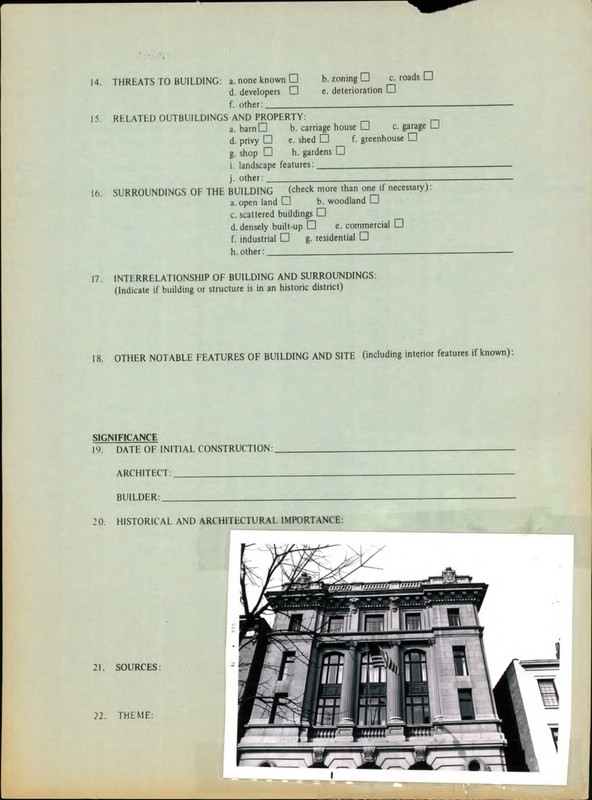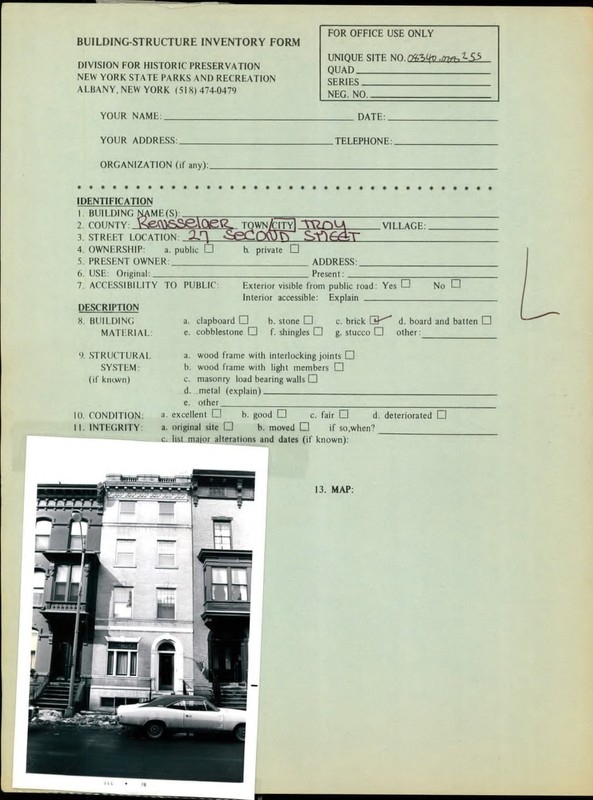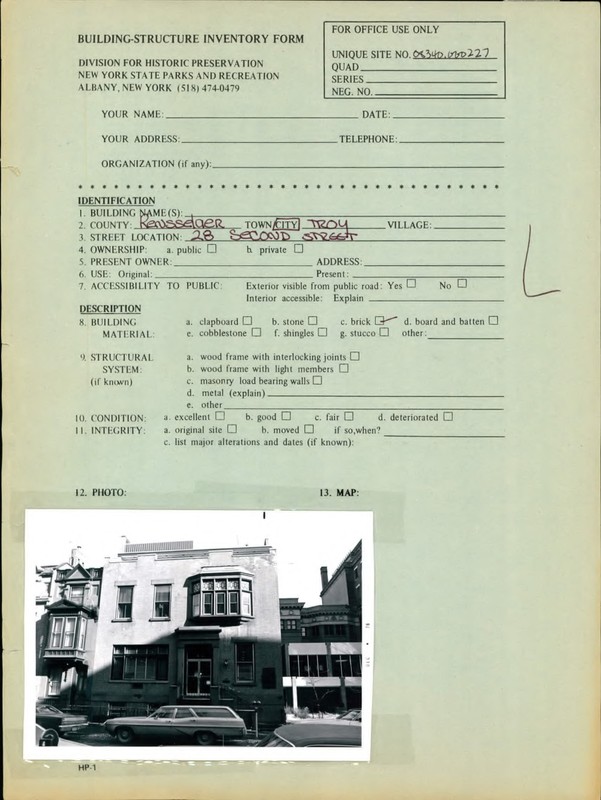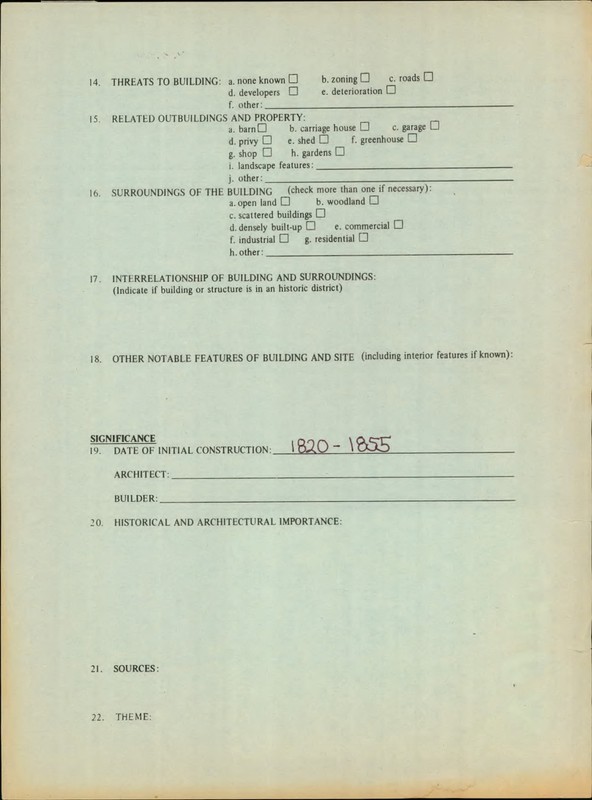Central Troy Historic District
Introduction
Text-to-speech Audio
The Central Troy Historic District is a National Historic District in Troy, NY. Second Street, located near the center of the city, consists of row houses and commercial buildings that date to the 19th century. The Central Troy Historic District incorporates five other historic districts, including the Washington Park, Second Street, River Street, Grand Street and Fifth Avenue Historic Districts. The building at 26 Second Street is one of the notable buildings in the district. A beautiful example of 19th century Victorian architecture, it displays design qualities of Flemish and Queen Anne Styles. Blending various architectural styles was common during the Victorian Era in the United States, as different communities and individuals drew on various styles to reflect their own identities.
Images
26 2nd Street

26 2nd Street Details

Troy Street Directory

Troy City Directory

Central Troy Historic District - 26 2nd Street Information

21 2nd Street Page 1

21 2nd Street Page 2

25 2nd Street Page 1

25 2nd Street Page 2

27 2nd Street Page 1

27 2nd Street Page 2

28 2nd Street Page 1

28 2nd Street Page 2

Queen Anne Row Houses in NYC

Backstory and Context
Text-to-speech Audio
The Central Troy Historic District developed during the 19th century as Troy became a major steel and textile industrial center, particularly in the manufacturing of shirts and collars. One famous landmark on 2nd Street is the Troy Savings Bank Music Hall located, which is listed on the National Register of Historic Places and is also a National Landmark. Built in 1872 and designed by the architect George B. Post, it building is remarkable in many ways, including that it symbolizes the wealth of the city of Troy during the 19th century. According to the National Register nomination form, “The hall was comparable in scale and embellishment to auditoriums in Europe and America and served as a cultural center when it was built. It remains one of the finest nineteenth century auditorium structures in the United States.”
26 Second Street was built at some point around 1875. This building is notable for its rather narrow facade, hiding the scale of the building, which is about 2,500 square feet. Second Street features various buildings that demonstrate the Federal and Greek Revival style, as some were built during the first half of the 19th century. 26 Second Street is representative of the Flemish revival style, which began to emerge during the late 1800s, but gained in popularity during the early 20th century. In New York State, especially in New York City, Flemish architecture was popular because of the Dutch colonial history in the state. 26 Second Street lacks a stepped gable, but the facade is decorated in a similar manner to other Flemish-style buildings from the time period. The building is made of red brick, and is part of a row of similar houses. The decorative balusters that contribute to the parapet atop the building and the elaborate wooden decorations demonstrate the Victorian motifs of the time period as well, especially the Queen Anne Style.
The Queen Anne style, which features qualities similar to the Flemish architecture, was popular in the Victorian era in the United States. Differing wall textures, such as wood design elements over brick or relief panels, are common in both styles. 26 Second Street also has an oriel bay window on the second story. Oriel bay windows protrude from the facade but do not touch the ground. The oriel window at 26 Second Street features beautiful wooden floral motifs.
According to the National Registry description of the Central Troy Historic District, 26 Second Street was formally Suzanne’s Beauty Salon, although no information regarding the dates of which this business was open are provided. The Registry also provides a succinct description of how the building contributes to the historical district and the neighborhood: “Three-story Eastlake style rowhouse with two-bay pressed brick side entrance facade and Queen Anne style detailing. Original features include brownstone basement, stoop and banding, window casing with incised decoration, a square bay window with incised decoration…a pedimented gable, patterned brickwork, and a heavy wooden balustrade.”
The links below provide more information about the various architectural styles and elements found in the row houses and buildings on Second Street.
Sources
“The Troy Directory, Also Cohoes and Waterford, Watervliet and Green Island, N.Y....” Troy Directory, 1829.
Department of the Interior. National Park Service. (3/2/1934 - ). New York SP Central Troy Historic District. File Unit: National Register of Historic Places and National Historic Landmarks Program Records: New York, 1964 - 2013. https://npgallery.nps.gov/AssetDetail/NRIS/16000367.
Department of the Interior. National Park Service. (3/2/1934 -). National Register of Historic Places Inventory Nomination Form. Troy Savings Bank and Music Hall. August 1964. https://npgallery.nps.gov/AssetDetail/NRIS/89001066.
https://catalog.hathitrust.org/Record/100734897
https://catalog.hathitrust.org/Record/100734897
https://catalog.archives.gov/id/75321192
https://cris.parks.ny.gov/Login.aspx
https://cris.parks.ny.gov/Login.aspx
https://cris.parks.ny.gov/Login.aspx
https://cris.parks.ny.gov/Login.aspx
https://cris.parks.ny.gov/Login.aspx
https://cris.parks.ny.gov/Login.aspx
https://cris.parks.ny.gov/Login.aspx
https://cris.parks.ny.gov/Login.aspx
http://daytoninmanhattan.blogspot.com/2011/06/charming-queen-anne-row-at-146-156-east.html
